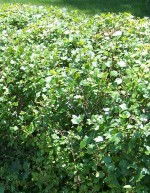 This deciduous, twiggy shrub with medium texture is a good choice for areas that can be challenging for less adaptable plants. It is easily transplanted and grown, tolerates a wide range of soils, and can be used in sun or shade (although sun is preferred.) The leaves are shiny and dark green all spring and summer until they turn dull yellow in the fall. Inconspicuous male and female flowers are produced on separate plants and female flowers are followed by red berries attractive to birds. Most of the cultivars of alpine currant that are sold, however, are male because of their apparent resistance to rust, so berries are not an important consideration when using the plant. Plants can be pruned any time of year and are useful as hedges or in massed plantings. Alpine currant is an alternate host for white pine blister rust and is banned in states where the disease is a problem.
This deciduous, twiggy shrub with medium texture is a good choice for areas that can be challenging for less adaptable plants. It is easily transplanted and grown, tolerates a wide range of soils, and can be used in sun or shade (although sun is preferred.) The leaves are shiny and dark green all spring and summer until they turn dull yellow in the fall. Inconspicuous male and female flowers are produced on separate plants and female flowers are followed by red berries attractive to birds. Most of the cultivars of alpine currant that are sold, however, are male because of their apparent resistance to rust, so berries are not an important consideration when using the plant. Plants can be pruned any time of year and are useful as hedges or in massed plantings. Alpine currant is an alternate host for white pine blister rust and is banned in states where the disease is a problem.
Type: Deciduous shrub
Outstanding Features: Cold hardiness; dense bright green foliage
Form: Upright mound
Growth Rate: Medium
Bloom: In conspicuous greenish yellow flowers
Size: 3-6’ H x 3-6’ W depending on cultivar
Light: Prefers full sun but tolerates shade
Soil: Average, moist, well-drained but tolerates less
Hardiness: Zones 2-7
Care: Prune at any time of year; prune hard to rejuvenate
Pests and Diseases: Usually disease resistance but susceptible to aphids, mites, scale, blight, leafspot, anthracnose, and rusts.
Propagation: Softwood cuttings, seed
Outstanding Selections:
-
‘Green Mound’ (2-3’ tall; male)
‘Spreg’ aka ‘Green Jeans’ (3-5’ tall; good leaf retention and leaves clean all season)
